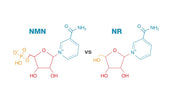
NMN vs. NR: Unraveling the Anti-Aging Potential and Structural Distinctions
, by Dylan Arrazati, 4 min reading time

, by Dylan Arrazati, 4 min reading time
NMN vs. NR: Unraveling the Anti-Aging Potential and Structural Distinctions
Aging, an inevitable part of life, has long been a subject of fascination for scientists seeking ways to slow down its effects. In recent years, two compounds, nicotinamide mononucleotide (NMN) and nicotinamide riboside (NR), have emerged as potential anti-aging agents, thanks to their role in boosting nicotinamide adenine dinucleotide (NAD+) levels. In this article, we'll explore how NMN and NR are linked to aging, with a special focus on their structural differences and how they affect their anti-aging potential.

The Crucial Role of NAD+
Before we delve into the distinctions between NMN and NR, let's grasp the significance of NAD+. Nicotinamide adenine dinucleotide (NAD+) is a fundamental molecule found in every cell, supporting various cellular processes. As we age, NAD+ levels naturally decline, contributing to aging and age-related conditions.
NAD+ acts like cellular fuel, enabling vital functions such as DNA repair, energy production, and cellular communication. A decrease in NAD+ levels compromises these processes, leading to aging-related symptoms like decreased energy, wrinkles, and declining health.
NMN vs. NR: Structural and Functional Differences
Structure: NMN consists of a ribose molecule attached to a nicotinamide group, forming a unique structure that facilitates its rapid conversion into NAD+.
Source: NMN is found in small quantities in certain foods like broccoli and avocados.
Conversion: NMN can directly convert into NAD+ with the help of enzymes, making it a potentially efficient precursor.
Nicotinamide Riboside (NR):
Structure: NR, on the other hand, has a more straightforward structure, with a riboside linked to a nicotinamide group. NR needs to undergo additional chemical reactions to be converted into NAD+.
Source: NR is also found in trace amounts in specific foods, such as milk.
Conversion: NR undergoes a series of enzymatic reactions to eventually form NAD+, which takes more steps compared to NMN.
How NMN and NR Relate to Aging
Numerous studies have explored the potential of NMN and NR to mitigate aging-related changes, backed by their influence on NAD+ levels. Let's look at their roles in the aging process:
DNA Repair: Both NMN and NR enhance DNA repair mechanisms, a crucial process that declines with age. This helps maintain genetic integrity and lowers the risk of age-related diseases.
Energy Production: Elevated NAD+ levels, facilitated by NMN or NR supplementation, can increase cellular energy production, leading to improved vitality and overall well-being.
Mitochondrial Function: NAD+ is essential for healthy mitochondrial function, which is vital for energy production. NMN and NR, by boosting NAD+ levels, may support better mitochondrial health.
Longevity: Animal studies have demonstrated that NMN and NR supplementation can extend lifespan and enhance health span, which refers to a longer and healthier life.
In Conclusion
NMN and NR hold significant promise in the pursuit of delaying the aging process. These compounds, as precursors to NAD+, have shown potential in scientific studies to counteract aging-related effects and promote overall well-being. Nevertheless, it is crucial to remember that while the research is encouraging, the full scope of their anti-aging benefits and safety profiles is still under investigation.
Should you consider NMN or NR supplements, consult a healthcare professional to determine the most suitable approach for your individual needs. Aging may be inevitable, but with the assistance of scientific advancements and a health-conscious lifestyle, you can strive for a more vibrant and youthful life.